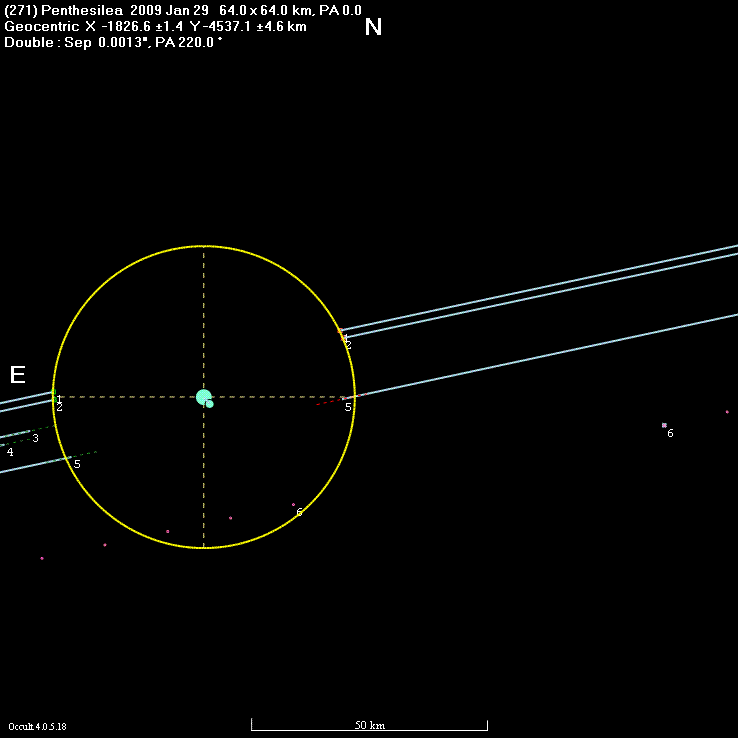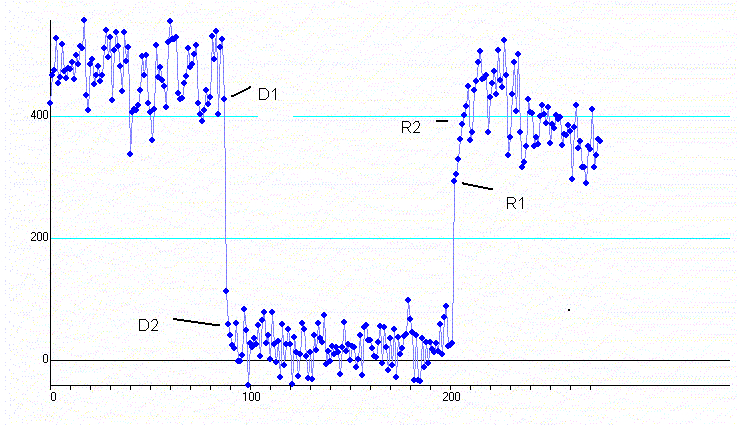|
|
Three positive events were recorded by using visual and video techniques.
View the updated prediction.
Observers:
1 J Bradshaw,Samford Valley, Qld, AU
2 J Bradshaw,Samford Valley, Qld, AU
3 P Anderson,THE GAP,Brisbane,QLD,AU
4 P Anderson,THE GAP,Brisbane,QLD,AU
5 T Napier-Munn,Bellbowrie, Qld, AU
6(P) Prediction

Discussion:
The circle above is plotted at the expected 64 km diameter of Penthesilea. With 3 chords it is reasonable to say that the central line of the event was close to Peter's visual observation. Both Peter and Jonathan reported a slow Reappearance.
The figure below shows the light Curve of Jonathan's observation which shows both D and R being slow and with the points chosen to represent the times. If this is caused by a double star then the separation is only 1.3 milli arc seconds and the PA 220 degrees. The star magnitude is given as m 11.8 and the asteroid (bottom of curve) m 13.9 then the secondary would be about m 14.2.

It is also noted that this seems to be the first observed occultation for (271) Penthesilea, and there is no data in the usual places for rotational lightcurve results.
Observational Data:
Observation details for MP (271) Penthesilea
By Star TYC 1397-00920-1
On 2009-01-29 at 12:56:00.0
_______________________________
Observer Jonathan Bradshaw
Location Samford Valley, Qld, Australia
Longitude +152:52:22.7
Latitude -27:21:22.8
Altitude 95 m
Datum WGS84
Telescope Dobsonian
Aperture 50 cm
Seeing Steady Clear
Timing GPS - time inserted Video with frame analysis
Disappearance 12:56:10.22
Reappearance 12:56:14.78
Comments: Clear and steady using GSTAR-EX with 2x integration and Gamma 6.
Subtracted 20ms from frame values. A late gradual dimming is seen in the light
curve with a corresponding gradual brightening toward the end of the reapearence
_______________________________
Observer Jonathan Bradshaw
Location Samford Valley, Qld, Australia
Longitude +152:52:22.7
Latitude -27:21:22.8
Altitude 95 m
Datum WGS84
Telescope Dobsonian
Aperture 50 cm
Seeing Steady Clear
Timing GPS - time inserted Video with frame analysis
Disappearance 12:56:10.26
Reappearance 12:56:14.86
Comments: Clear and steady using GSTAR-EX with 2x integration and Gamma 6.
Subtracted 20ms from frame values. A late gradual dimming is seen in the light
curve with a corresponding gradual brightening toward the end of the reapearence
_______________________________
Observer Peter Anderson
Location THE GAP,Brisbane
Longitude +152:55:57.9
Latitude -27:27:42.3
Altitude 170 m
Datum WGS84
Telescope Newtonian
Aperture 41 cm
Seeing Steady Clear
Timing Tape Recorder + time signal Visual, PE applied
Disappearance 12:56:11.20
Reappearance 12:56:14.60
Comments: Was checking the field when the star disappeared (silly)
When it re-appeared it was about 1/3 brightness for half a second then jumped
to full brightness - stepped appearance. Time quoted is first re-appearance.
_______________________________
Observer Tim Napier-Munn
Location Bellbowrie, Qld, Australia
Longitude +152:53:7.5
Latitude -27:33:29.5
Altitude 52 m
Datum WGS84
Telescope SCT including Cass and Mak
Aperture 36 cm
Seeing Steady Clear
Timing Stopwatch Only duration timed
Disappearance 12:56:08.00 (absolute time adjusted)
Reappearance 12:56:12.30 (absolute time adjusted)
Comments: The event happened between 1056pm and 1057pm (12:56UT and 12:57UT) and the duration was 4.3 secs approx.